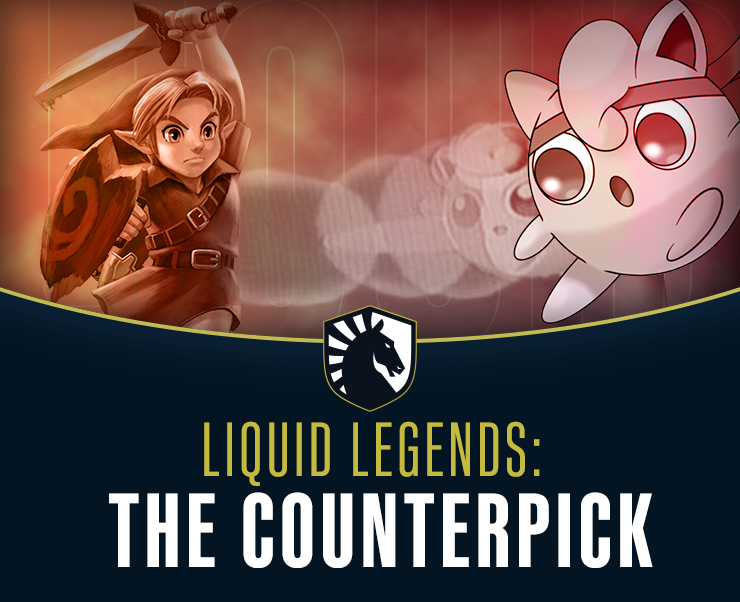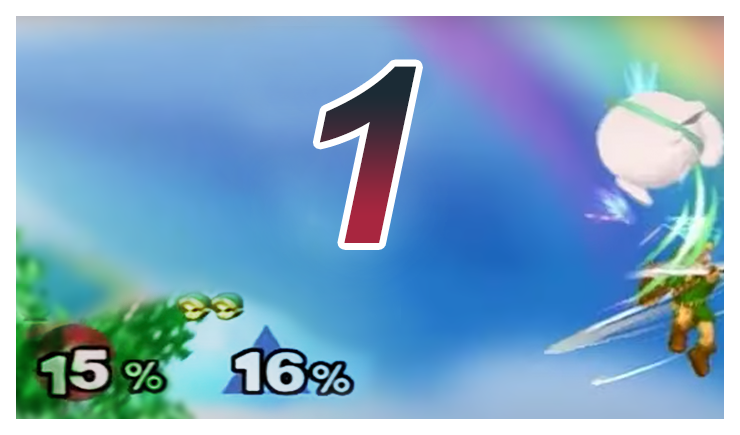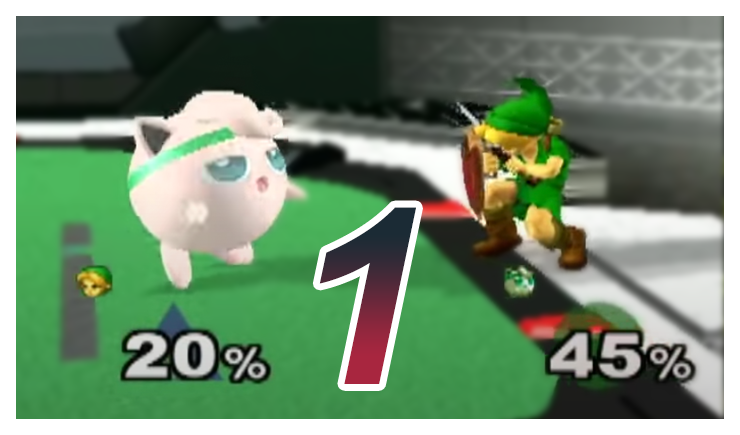Liquid Legends: The Counterpick

Moving Past the One Tap
Unlike the two spacies (Fox and Falco), Melee’s mainstay floaties were not created equal. Puff is solidly better than Peach in a lot of respects and wins the matchup pretty handily. (To see that in action, see TurnDownForWalt’s video below. This is one of his best videos.)
According to Liquipedia’s records, across the decade-long rivalry the two had, Armada picked Peach against Hungrybox just once: at Apex 2010, where he lost in Winners and Grand Finals 5-0.
In 2010, the era of the 5 gods was just about in full formation. That year specifically, Hungrybox was in a great position. The only player he really feared was Mang0, who spent the year sandbagging by playing secondaries. Hbox had a solid read on Mew2King, was brutalizing PPMD, and for Armada, a 60-40 matchup.
While set scores won’t lie, they will mislead. Despite two 3-0’s and a very good matchup, Armada at least made Hungrybox sweat, bringing every game except one to a lost stock situation. In two games, Hungrybox had to clutch things out from fairly deep deficits.
True to his title, Armada was a god of the game and he juiced the losing matchup as much as he could. In the TDFW video above, at about 8 minutes Walt highlights Llod’s strategy to throw turnips directly upward as a way to keep stage control. Armada was doing something similar (albeit less refined) back at Apex 2010.
Still, Armada’s exceptionally strong theory of the game couldn’t carry him past Hungrybox and it couldn’t carry him past Mang0’s Puff either.
“At this point I’m starting to realize: this is not working,” Armada said of Puff in the Melee documentary METAGAME. “Regardless of what people say about the matchup, it’s not working for me and I have to find an answer.”
This character kills floaties
In Melee, the tier list matters. At least, if you want to win tournaments.
Melee wasn’t made with competitive balance in mind and so low tiers and mid tiers have much smaller toolkits and much bigger handicaps than the high and top tiers. So it went for years with Young Link, who has stayed a consistent low-to-mid tier for Melee’s near two-decade lifespan.
However, many mid or low tiers have quirks that can make them effective in certain matchups. For example, Young Link is surprisingly decent against the floaties. To the point where, even now, Puff is Young Link’s best top tier matchup and the only one that’s arguably even.
Matt "bambi" Deslatte, one of the best Young Link players in modern day Melee, says it’s, “definitely the best top tier matchup for Young Link.”
“I feel like it's probably close to even,” he tells me of the matchup, “and regardless of if Young Link loses I’m happy if my bracket has Puff in it.” To bambi’s point, he recently started co-maining Falco and uses the bird against the other top tiers.
“Young Link doesn’t have great ways to beat shield and cc [crouch cancel] besides his risky grab,” by noting this, bambi explains one of the main factors keeping Young Link out of high tier. He struggles to beat a character that stays grounded and uses smart shield patterns.
(Rishi’s video provides a good primer on the character)
Fortunately for Young Link, Puff prefers the air. Puff has some decent options on the ground but as bambi says, “Puff isn't gonna get anything done without jumping.”
Young Link not only moots some of Puff’s offense but her defense as well. Normally, floaty characters are harder to combo but Young Link’s bombs, boomerangs, and even grabs lead to follow ups and kills.
One Liquid player knew this all the way back in the MLG days (circa 2005). Before anyone was picking Young Link against Puff, ChuDat was picking it against Peach.
Peach has long been one of the Ice Climbers worst matchups because they can’t challenge her aerials and she has so many ways to avoid the ICs high-reward grab. At MLG Seattle, ChuDat brought out Young Link to deal with two of the world’s best Peaches at the time—Sastopher and Kei.
(The “do I look like I know what a jpeg is?” era of Melee)
ChuDat narrowly beats Sastopher and narrowly loses to Kei but in both matches, you see Young Link’s potential. His projectiles mean he can effectively camp the floaties and his large, lingering aerials mean he can challenge them in the air. Even more importantly, his bomb confirms into a down air (0:45) or up air (1:40) for a kill.
Young Link is far from a perfect counter for Puff or Peach, but he’s a mostly unknown mid-tier with a surprisingly even matchup. And that means more than it sounds.
Secret weapon
Armada has said in METAGAME and multiple videos that the guiding principle of his counterpick was matchup knowledge. Europe had a small Smash scene with few Puffs, so Armada could never practice the matchup. In order to level the playing field, he wanted to play a character that Hungrybox couldn’t practice against.
Young Link was just that. Even today, for many unsuspecting Puffs Young Link is still that.
At Frame Perfect 5, bambi got a huge upset win by beating Puff main Michael (ranked 50th). “When I played Michael,” he writes, “I definitely found a few kills that would have been much harder if he had had more experience.”
When Armada found Young Link, he was so intent on keeping the weapon secret that he told the Smash scene in Sweden to write nothing and say nothing about his counterpick—not until he unveiled it at Pound V. The secret weapon worked wonders.
Hungrybox treated Young Link like any weak character, trying to abuse the matchup with oppressive aerials. But Young Link’s defensive game against Puff is surprisingly good. Armada simply pulls out a bomb, waits for Hungrybox to approach, then jumps and throws the bomb out of shield. It not only bails Armada out of scrambles and bad spots but often reverses the pressure and nets him a kill.
Game 2, while Hungrybox is dying to bomb-confirms, Armada looks unkillable. Dreamland - a high-ceiling stage that normally benefits Puff - now benefits Armada. Hbox can’t find a rest or an edgeguard and relies on raw up airs and back airs (bairs). Armada lives to 174% on his second stock. Armada wins decisively, 2-0.
50/50
At Genesis, Hungrybox often went on the attack, making for what would be an uncharacteristically quick Young Link-Puff set. In reality, Young Link-Puff was important to Melee because it was one of the earliest wars of attrition in the Five Gods era.
Or, as bambi says it, “the first set Armada and Hbox played went pretty quick bc Hbox rushes in like a dummy.”
At Genesis 2, Melee was about to see a new side of the game and matchup. A slow, deliberate side that many people would hate.
The Genesis 2 set is a 3-1 that goes on for about 32 minutes. It features two timeouts where Hbox and Armada angle for small bits of damage and then play keep away with the lead. For Young Link, this looks like throwing out endless projectiles and platform camping. For Puff this looks like using her aerial mobility to camp just outside of the shooting gallery.
Although game 1 has one of the coolest endings in Melee, it’s overall an ugly set—and not just for the gameplay. The commentary on this set is so bad that comments are still turned off and it requires a disclaimer.

“Gay” gets dropped as an insult every minute and a half, the commentators dive surprisingly deep into some wild toxic masculinity, and the r-word’s in there a few times just to round out the “Edgy Gamer” vibe. On top of that, they’re constantly wrong about the matchup—so wrong that audience members step to the mic to argue with them.
It’s a sh*t-show but it’s also 2011 Melee and the scene (and the commentators involved) have since forsaken that kind of commentary. Even still, the commentary provides an interesting root from which you could trace out a forest of floaty hate and projectile hate that still lingers in Melee today.
One year later, at the next Apex (2012), Armada and Hbox would meet again in the Grand Finals. This time, Hungrybox has prepared and he’ll show why the matchup is at least 50/50 for Puff.

Hungrybox makes a few key adaptations:
1. He’s more grounded and will approach by wavedashing and shielding. This forces Armada onto Young Link’s mediocre ground options and pressure more often. It also leaves less openings to get hit by an aerial bomb and eat damage or death.
2. He puts better pressure on Young Link. Hungrybox understands how to space around Young Link’s shield and even dwindles the shield so low that Armada can’t hold shield, jump, and bomb throw (see 14:10). Off stage, it’s clear he knows the edgeguards better too. In the exchange below, Hbox smacks a boomerang away and bairs Young Link’s up-b at a visually deceptive spot.
3. Hungrybox plays around the projectiles. He brings out the light shield a lot more - which helps maintain Puff’s shield health. He also finds a gap in the projectile pattern where the bomb can’t quite hit him and he can slap the boomerang away with a bair. Commentator DogySamich notes that he probably gets this from Seibrik, a top Brawl player who coaches him in the set.
Overall, Hungrybox plays more aggressively too. He uses empty movement and peculiar drifts to bait Armada into unsafe moves. It’s enough for Hbox to win his first Young Link set, but not the tournament. He resets the bracket, 3-2. One more set to play.
Not finished yet, Armada changes up his timings and brings in more arrows and up airs to add to the obstacle course. He also brings in Pokemon Stadium and uses the length and transformations to ruthlessly camp Hbox out, winning the Grand Finals reset and the tournament in a set that goes for nearly an hour and fifteen minutes.
Let’s start a war, a counterpick war
Yet another year later, yet another Apex (2013), Hungrybox does not want to see history repeat itself. He doesn’t want to lose in another war of attrition. So he brings out his own secret weapon: Ness.
Ness is even worse than Young Link—a definitively bad character with nearly no results. Armada’s counterpick has been so effective that it’s pushed Hbox all the way down the tier list and started a counterpick war.
Ness is a bizarre pick but not without its reasons (the obvious being matchup knowledge).
The other reasons are likely that Ness had a better time against Young Link’s bomb and an easier time closing the stock. Though Ness’s aerials take a while to wind up, they linger, some are disjointed, and they can hit pretty hard.
Hbox uses Ness’s weirdly timed aerials to trip Armada’s jump-bomb throw timings up, constantly winding up an aerial and hitting right as Armada goes to pull a bomb. Hbox also has a bizarrely easier time contesting the bomb because Ness’s forward air (fair) can outspace the explosion. In both games he gets Armada to last stock and in the second game he gets him to last hit.
Yet, Puff still does better for Hbox in the set. He switches back to Puff, wins on Yoshi’s Island and gets pretty close on Pokemon Stadium. Armada wins 3-1. Another loss, another tournament, another character.
To make matters worse, in their next set at MLG Anaheim, Hbox slipped backward. He changed his approach to be fully aggressive, rarely camping and keeping up tight pressure. Problem is, if the pressure slips at all, Young Link can either reset the situation with a fast move or get a kill with a bomb, boomerang, or grab.
After getting 3-0d going all Puff at MLG Anaheim, Hbox doubles down on the top tiers. Enter Hfox.
At CEO 2014, Hungrybox brought out Fox—one of Young Link’s worst matchups.
Young Link has to work much harder in the matchup against Hungrybox’s Fox, because he has a super linear gameplan that works surprisingly well against a literal god of the game.
Hungrybox aims to beat Young Link on the ground and call out Young Link’s aerial options with a fast up smash or nair. After he gets Young Link to a high enough percent, he wants to get a knockdown with a drill-shine, a nair, or grab, because Fox is so fast that he can race over and kill Young Link with a tech chase up smash.
Hungrybox brings Armada to last stock and even to last hit some games but HFox is clearly underdeveloped. After all, Fox is a demanding character and Hungrybox only wants to use the character against Armada.
But it means that Armada can handily beat the Fox using Peach—a well-versed matchup for Armada—and can still eke it out with Young Link.
Armada reads Hungrybox’s gameplan pretty well. To adapt, he switches from bombs to boomerangs. The boomerangs force Hbox to shield and stop running, and they’re better at intercepting Fox’s recovery than the bomb. Armada also stymies more of Hbox’s approaches using Young Link’s fast, disjointed fair and abuses Hbox’s poor disadvantage with up air combos and down smashes on spot dodges and whiffed recoveries.
Given more labbing HFox might’ve been enough to beat Young Link. The game plan was solid provided that Hbox could hit good Firefox angles while recovering or multishine for shield pressure, but the execution wasn’t quite there.
After CEO 2014, it was anyone’s guess what Hbox would bring out next. Each character had a silver lining in the matchup but each one clearly fell short. At EVO 2014, it was the Hbird.
Hbox approached the matchup with Falco in a similar way to Fox and ran into similar problems. He had a linear game plan built around dairs, f-smashes, and lasers and his Falco simply didn’t look clean enough to cut it. Armada cooked the bird the same way he cooked the fox.
Down to the very end of the counterpick war, Hbox finally opted out of the counterpick and back into the matchup.
Shockingly, he came into the set looking better than ever. Hungrybox had correctly identified that Young Link struggles with shields and grounded approaches but he also knew now that wavedashing wasn’t the thing to do.
Instead, he’ll sit patiently in shield because he knows Armada won’t grab very often. Young Link’s grab is so poor that Hbox could feasibly react to it - and if Hbox reacts well enough, he can get a free rest off the whiffed grab. While he shields, he’ll let Armada throw out some moves, read the pattern, then approach.
Hbox also took what he learned from edgeguarding in Apex 2013 and applied it in tandem with the ledge. Hungrybox saw that Armada would often go to the ledge or around it and recognized that he could camp that spot every time he knocked Armada off stage.
Hungrybox could use the invincibility the ledge gives to reliably contest Young Link’s recovery. If Armada tried to move around Hbox, Hbox just tracked the landing and got a grab. This way, Hbox applied more consistent, unpunishable pressure to Young Link than he ever had before.
Notably, not a single one of these games went to timeout. Hbox had also gotten much better at managing the lead. Rather than completely camp out Armada in the air or rush him down on the ground, he looked for patterns in Armada’s projectile wall and then used those to find safe jump-ins.
This was huge for Hbox because while Puff can win the timeout, it’s very risky. Young Link gets such easy kills off of bombs and has so many ways to build damage that in 8 minutes, Armada usually found ways to erase Hbox’s lead. Puff also takes the worse position in terms of pressure during the timeout, having to hover in the air at the edge of the stage, with less space and less distance to the blast zone.
Hbox also knew the matchup even better than before. He punished Young Link’s whiffed moves more effectively, spaced bairs so well he could pressure Young Link’s shield safely, and he rolled away instead of jumping, making it hard for Young Link to land bombs.
There are points where he knows the matchup so well that he beats a Young Link down air (dair) with an up air in an interaction that makes no visible sense. Also look at the SDI on this bomb.
(Good god.)
Armada isn’t totally lost. He adapts and goes up 2-0 in Losers Finals by playing a much more stage control-based game. He’s empty hopping a lot more, throwing bombs forward but varying the timings slightly, and almost exclusively throwing retreating aerials and jumping slightly backwards in order to bait Hbox.
But Hungrybox has beaten this demon. He recognizes how Young Link can be edge guarded if Puff can catch the startup of the up special and he starts chasing Armada off stage, fairing him right as he tries to recover. He recognizes Young Link can be comboed and tech-chased on platforms and starts getting much bigger rewards off the hit.
He reverse-3-0’s Armada and turns the matchup into what he argues is Puff’s favor - 55:45.
(A full stock down, game 5 at EVO, Clutchbox awakens and plays the best he ever has against Young Link)
Full circles
We’d never see another classic Young Link-Puff match from Armada and Hbox. 2015 on, Armada would take Fox into the matchup instead. Ironically, he dropped Young Link for the same reason he picked him up: Because no one practiced the matchup.
On a stream with Izaw, Armada admits that he hated the matchup. If it was boring to watch, it was (in Armada’s words) “incredibly f-ing boring” to play - to the point that Armada struggled to find sparring partners. Almost no players wanted to help him in the matchup because they didn’t want to play it.
Starved of practice and in need of a better secondary to face the spacies anyways, Armada went all-in on Fox. This switch would leave a Fox-shaped crater in the face of the meta, sparking many players to take to Fox to beat Puff. Bambi recollects a quote from Armada about how in the long-run, that may have just lent to Hungrybox’s dominance.
“Hbox would be less dominant if people started using more characters against him, like zain and amsa,” bambi paraphrases, “because then he has to focus on way more than just the fox matchup.”
Still, the Young Link made its mark too and you see the pick return every now and then. Aklo brought it out against Hbox just last Friday, where Hungrybox won. Then, of course, there’s Axe’s Young Link.
Axe tried to do what Armada had done for years, picking Young Link to avoid a terrible matchup for his main, Pikachu. Axe had much less success. His biggest moment in the matchup was Super Smash Con 2017, where he nearly reverse-3-0’d Hbox. Despite Axe’s results, he’s the Young Link that Bambi finds more to learn from.
“I think I learned a ton of my tech and stuff from watching Axe. That guy still blows my mind when I go into his stream and he picks Young Link. Axe definitely like, enjoys the character and plays him for fun a ton more, and that really shows in his play.”
Axe also plays Young Link more aggressively, using nair a bit more like Fox’s - to take control of space and create mix-ups on shield. He’ll also go out on a limb every now and again and take a big swing. This is something Bambi thinks may be more optimal than Armada’s hard-camp approach.
“Armada is also very stubborn,” he writes. “There are sets where neither of them are being proactive at all and just nowhere near each other. The thing is if you just throw the bomb at max range and run, you don't get anything off of it. It's up to 14%, but if you play closer ranges and stay poised you can pile on lots of damage really quickly and I think you can definitely play for big damage like that and still be pretty safe.”
Nowadays, players like Axe and Bambi have brought Young Link full-circle in terms of popularity with that slightly more aggressive style. Axe’s run in Summit’s Swag Bracket was some of the coolest Melee ever played.
Even in the 2017 set above, you see a full-circle for the culture around the matchup, where the crowd and commentary hype up the matchup. This is wild because the commentator in this set is the same as at Genesis 2: HomeMadeWaffles. HMW goes from actually asking the crowd not to cheer for the players at Genesis 2, to counting down the timeout and encouraging Axe to camp it out.
2011 to 2021, a decade is a lot of space to change and everything has changed—from the commentary, the character-bias, and the matchup itself. The Puff-Young Link matchup still lives on, only now more through bambi than Hbox. Though Hbox may see it occasionally, bambi came up playing strong Puff mains like Miffee, atomsk, and Dawson.
For Hbox, the Young Link chapter is mostly closed, but for many players like bambi and Dawson, the matchup is a story that hasn’t fully finished.
Writer // Austin R. Ryan








